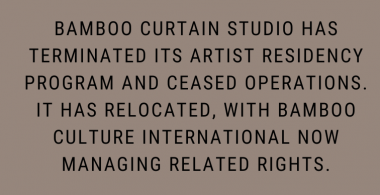- Login to post comments
Artists Mobility: A brief Guide to Art Residencies in Asia
by Julio Areck Chang
→→→ Main Index
What is artists mobility?
The concept of artists mobility encompass different names and forms around the world, like artists exchanges or cultural exchanges, travel grants, fellowships, international studios, etc, but in this study it can be understood in two ways: the first meaning is a program or a period of time (a residency) in which an artist, a curator or a researcher can concentrate in his or her creation process, away from his or her usual home. The other meaning (a residence) refers to the physical venue where that practice takes place. Usually, but not always, both interpretations come together in an experience that combines a creative activity in a nurturing space.
What options are there for artists mobility?
Based on the aforementioned definition, there are at least two different categories:
In Artist in Residency programs, usually run by institutions like galleries, museums, public cultural organizations or artist communities, artists are selected according to their skills, merits or potential, in order to have a creative experience during a specific period of time. Typically, the institution covers part or all the expenses of the artist’s living during this time. In some cases, the artists are asked to give something in return, like a number of the artworks created during the residency, or participation in courses, workshops, etc. In artist communities, artists usually engage together in enriching local and international cultural exchanges. Many Artist in Residency programs own an actual place for accommodation, but others simply rent hotels or guest houses as needed.
On the other hand, Art Residences offer an appropriate place where artists usually can freely go without any competitive selection and stay as long as they want. These venues somehow act as hotels or retreats for artists, where they normally have to pay a fee for their expenses and they are not required to give anything of their creative work in return.
Of course, these categories offer a very wide range of possibilities, up to the point that all art residencies run in different ways and have different characteristics. Art residences can be part of bigger institutions or be stand alone enterprises; be as big as able to accommodate 20 or more artists, or as small as having only 1 artist at a time; having large facilities close to fancy cultural areas in big cities or be small huts in the middle of secluded rural areas; provide a place where the artist actively interacts with the local community and other artists from around the world, or a quiet retreat in order to focus in art creation without any distraction; make open calls or send exclusive invitations; have their own funding to sponsor the artists, make the connexion to international organizations that grant the artists, or simply charge the artists for all the expenses.
Which are the benefits of artists mobility?
Artists mobility have advantages for both artists and societies. For artists, becoming a resident brings the opportunity to be in an encouraging place where they can focus in their creative processes and have enriching exchanges with other artists and cultures. But communities can have benefits as well: artists can actively help and interact with local people near the residence, thus encouraging cultural, social, historic and ecological values and addressing specific issues like women’s rights, discapacity, etc. Moreover, in an international level artists mobility is a good way to improve arts development, to support cultural diplomacy by means of promoting countries and their cultures, to increase the awareness of the economic value of cultural and creative industries and therefore contributing to trade development, and to be an instrument of international aid in culture development.
Art Residencies in Asia
The first thing that has to be noted about the art scene in Asia is diversity: this vast continent is full of very different cultures that will surely appeal to Western artists with their colorful lifestyles, ancient traditions, mystical religions, breathtaking landscapes, delicious food and exotic ways of life. No wonder why in Asia art residences come in a big array of options, from big cultural complexes in Seoul to small ecological residences in the Philippines to rural studios in the middle of the mountains in Chiang Mai; from fancy art galleries in Singapore to a cozy house in a packed Indian street; from bizantine-era sites in Jordan to funky studios in Taipei: artists surely can find a lot of inspiration in these vibrant and enriching Asian residencies.

